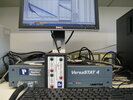Electrochemical impedance setup
The setup is versatile and could be used for many electrochemistry applications, in our group it is mainly used for measurements on coated metal substrates. Electrochemical impedance measurements are widely used for evaluating coating performance. In our group the water uptake process into nylon on an aluminum substrate was measured and compared to MRI results. Further, the water uptake process into a weathered polyurethane coating was investigated.
A special cell holds the Perspex cylinder on top of the coated metal. This cylinder is subsequently filled with a sodium-chloride solution (0.05 M) which forms one side of the electrode pair. The other electrode is the metal substrate underneath the coating. As the electrolyte solution is applied on top of the coating, water and perhaps ions start to enter the coating. The changing properties of the coating are monitored by EIS and give information about the diffusion coefficient of water and the barrier properties of the coating.
Between the two electrodes a constant potential (~10mV) is applied with a certain frequency (0.1 Hz – 1 Mhz) and the resulting current is measured. Current and voltage combined gives information like impedance and phase angle. From the impedance quantities like the film capacitance or film resistance can be calculated.
